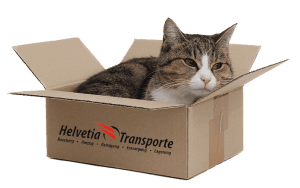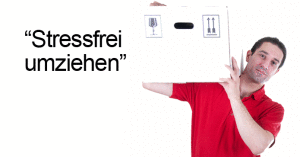Removal Checklist
Helvetia Transporte & Umzüge AG

When moving, you need to think of a thousand different things. What is often forgotten is that pets also need to be prepared for the change of residence.
Thus, the move is safe and stress-free for the animals.
Introduce your pets to the new home; you can also consult the Check-list for the relocation of animals.
1 month prior to moving with animals:
Organizing a pet sitter for the move (if possible people familiar to the animal)
For dogs: Register you dog in new town and un-subscribe from the old location
For exotic species: Note the reporting obligations!
For cats: Think of a cat cage and cat harness
1 day prior to moving the animals:
Keep the phone numbers of veterinarians at the old and new town and water bottles ready, to avoid or handle any sudden change due to stomach discomfort.
On moving day, and thereafter:
Moving with an animal: keep its usual food, bowls, favourite toys, sleeping accessories and care utensils ready, hire the usual pet-sitter
Be careful with the sedatives: necessarily addressed by the official veterinarian!
Important during prolonged transport: Breaks for the pet as per their schedule! Upon arrival let it explore the new home
. Set up quiet place for it to sleep near familiar objects as a retreat point
for at least 4 weeks after the animals move to the new home.
We will inform you in detail about your move so you can save valuable time. Many things can now be easily done online. Our Moving Checklist will help you to maintain an overview of the planning and implementation.
The primary preparations
- Make a plan for the move
- Do cosmetic repairs in the old apartment
- Visit the new apartment and measure the stairwell
Four weeks before the move
- Provide a forwarding request at the post office
- Re-register: Change Bank, electric utilities, kindergarten/school, employers, doctors, health insurance and insurance companies, magazine and newspaper subscriptions, institutions and associations, home delivery services, Phone/Internet, Current Financing/Leasing to new address
- Check whether all the keys to the old apartment are available
- For major damage in the apartment: Engage craftsmen
Two weeks before the move
- Organize adequate number of moving boxes
- Get tape and stickers
- Inform new and old neighbours of the move
- Apply for the parking reservation at the district or regional guard post (at least 7 days before the move.) If desired this can be applied through us with no extra charges (invoice of the municipality will be sent directly to you.)
A week before the move
- Schedule handover of the old apartment
- Get keys to the new apartment
- Pack (not too heavy) and label the crates
- Water the plants only moderately so that they are lighter
- Photograph the faults in the old apartment
A few days before the move
- Empty the fridge and fully defrost freezer
- Pack the extra chest with: Soap, toilet paper, cleaning cloth, paper towels, garbage bags, cleaning utensils, tools, string, tape, box cutters, pencil, fuses, extension cord, flashlight, light bulbs, plaster and mobile phone
- Have the lamps for new apartment ready
Moving day
- Hang furniture parking plan in the new apartment
- Explaining the moving staff what is to be put down where
- Show helpers, in which boxes fragile items are stowed
- Put out toilet paper, towels and soap
- Note any damage to the furniture or the apartment
After the move
- Dismantle the nameplate on the door and letterbox at the old apartment and assemble it at the new apartment
- Note electricity meter reading
- Make a housing snag list and send it to the new owner within ten days by registered mail
- Sort documents supporting the costs for tax purposes
- Reclaim Deposit
- Rate Helvetia Transporte & Umzüge AG

All boxes are packed, the collection date is set. Now arises the only question: Move on your own or engage professionals?
If you want to move, you can either do all the work on your own or hire Helvetia Transporte & Umzüge AG. Both variants have advantages and disadvantages that you should consider before moving. If you hire Helvetia Transporte & Umzüge AG for your relocation, the costs are higher but the experience is less stressful. Depending on the extent to which you entrust the company, you have either little or almost nothing to do with packaging, packing, transporting and unpacking.
Our comprehensive service package allows us to do a lot more for you in one move: On one hand, we take care not only of the move but even of the cleaning (purchase guarantee) and the disposal we perform for you. Each service has an added value for you.
We offer the following services:
- Relocation
- Transports
- Furniture lift
- Removal and disposal
- Cleaning services
- Storage
- Removal shop
What you should consider cleaning in the apartment – our cleaning tips.
Remove Stickers
With a normal hair dryer any sticker residue and stuck labels can be removed gently. For this purpose, the adhesive residue is heated and removed with a spatula or knife. For painted surfaces, the surface is not scrubbed harshly in order to avoid putting any real pressure on the surface so that the old paint is not damaged.
Plastic windows/strong>
To clean the windows, warm water with the addition of a little detergent is recommended. Damaged sections can be repaired with a suitable colour.
Floor coverings
Fitted carpets and felts require expert shampooing (extracting with the appropriate equipment that you can rent at the drug store is the best method). Remove any stains.
Sealed parquet
To be cleaned with special warm and light material and then wiped dry; completely remove any adhesive residues of carpet tape.
Wood
All timber furniture, doors, window frames, curtain boards etc. (painted or stained) thoroughly with soap and water. Keep in mind to work from the top down and not too dry excessively, so that no lines are visible. Then rub dry everything. Treat stubborn stains and dirt carefully with a stronger agent.
Closets
Thoroughly flush with soapy water and wipe dry. Remove contact papers and rest of packaging paper. Remove any adhesive residues with thinner or turpentine (Caution – use only with the window open and do not smoke in the vicinity).
Drawers
Are to be removed, so that the rear and rear sides and guide rails can be cleaned. Door handles/sockets and buttons should not be forgotten. Clean switches and sockets thoroughly (Caution – use no liquid).
Basement
Wash, sweep and allow it to dry thoroughly.
Mail and milk box, Signage
Thoroughly clean, remove labels.
Do not use
No alkaline, acidic and aggressive detergents may be used (except for faucets). Oil wooden blinds and brush sun-blinds thoroughly.
Do not forget
The fittings and connecting rods, roller blinds, Venetian blinds, shades and sun blinds should be thoroughly cleaned inside and outside with warm water and the addition of a mild detergent (individual slats). Be sure to rinse with clean water and rub dry (roller blinds and Venetian blinds).
Clean walls and ceilings
Of course, walls and ceilings are not exposed to the same pollution as floors but damage still shows up on these surfaces over time. The cleaning method is, however, dependent on the nature of the material. Emulsion paints, gloss paints, latex paints and vinyl coated wallpapers are washable up to a certain extent. Also paints of very good quality can be washed. Basically, the overall condition of walls and ceilings must be taken into consideration before cleaning. The impact of a single cleaned point needs to be considered because a thoroughly scrubbed spot looks very different as a clean spot from a more or less soiled spot. In this case, you should decide whether it is better to wash the entire wall or renovate it completely. When cleaning entire walls, the heavily polluted sites on radiators, light switches and edges of picture frames, are first to be wiped and treated with the cleaning solution. That is best done by testing in a corner of the wall and then applying it in wide strips from top to bottom. Here, the sponge must be used in overlapping strokes, both vertical and horizontal strokes over the surface and then wiped almost immediately after and patted dry. Generally, it must be ensured that no water gets into or behind the wallpaper seams, otherwise the wallpaper will be loosened from the surface. Finally clean the baseboards, window frames and doors. Certain unusual wallpaper, like textile or metallic wallpaper, are in principle not be washed off, these can be cleaned with a vacuum cleaner. For non-washable wallpaper, you should consider whether it makes sense to treat the contamination. There is a risk that it may damage the surface if too much pressure is exerted. However, some techniques are appropriate for all wallpaper -except the ultra-sensitive type. The slightly soiled areas on the walls can be cleaned with a soft, non-marking eraser. Even a rolled up moistened white bread into a ball serves the same purpose.

